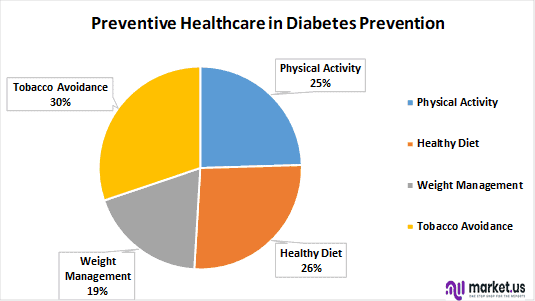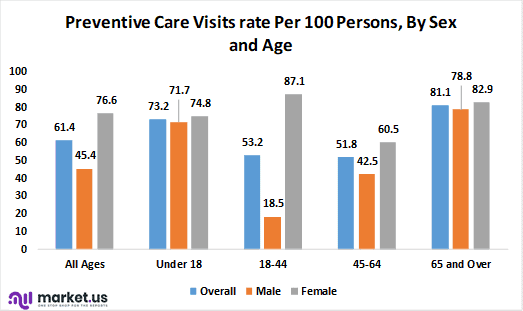According to Preventive Healthcare Statistics, Preventive healthcare also known as preventive medicine or preventive care, refers to the measures taken to prevent diseases, injuries, or other health conditions before they occur or progress.
Preventive healthcare includes various aspects such as regular screening, vaccinations, lifestyle modifications, and education on healthy behaviors.
Table of Contents
Editor’s Choice
- Noncommunicable diseases (NCSs) such as cardiovascular diseases, cancer, chronic respiratory diseases, and diabetes account for approximately 71% of all global deaths.
- Preventive healthcare services can reduce premature deaths by about 40%.
- The CDC estimates that for every dollar spent on preventive services, the healthcare systems save between USD 2 and USD 10 in future costs.
- The influenza vaccination coverage among adults in the United States in 2019-2020 was around 48%.
- The global preventive healthcare market is projected to reach USD 345 billion by 2029 at a CAGR of 9.6%.
- 90% of the nation’s $4.1 trillion in annual healthcare expenditures are for people with chronic and mental health conditions.
- More than 877,500 Americans die of heart disease or stroke every year.
Prevalence of Preventable CVDs
- Cardiovascular diseases are the leading cause of death worldwide.
- About 19% of people died from CVDs in 2019, which represents 32% of all global deaths. Out of these deaths, 85% were due to heart attack and stroke.
- About 80% of premature heart diseases and strokes can be prevented through lifestyle modifications such as a healthy diet, regular physical activity, and avoiding tobacco use.
- In the United States, cardiovascular diseases are responsible for approximately 1 in 4 deaths.
- 1 person dies every 33 seconds in the United States from cardiovascular diseases.
- About 695,000 people in the United States died from heart disease in 2021.
- Blood pressure control reduces the risks of cardiovascular diseases by 70%.
- Tobacco avoidance, a healthy diet, and regular exercise reduce the risk of cardiovascular diseases by 80%, 65%, and 75% respectively.

Prevalence and Prevention of Diabetes
- In 2021, about 537 million adults worldwide had diabetes, and the number is projected to reach 642 million by 2040.
- Type 2 diabetes, which accounts for the majority of diabetes cases, is largely preventable through regular physical activity, a healthy diet, weight management, and avoiding tobacco use.
- The global prevalence of T2DM in adults was about 536.6 million in 2021. This number is expected to reach 783.2 million people in 2045.
- Between 2000 and 2019, there was a 3% increase in diabetes mortality rate by age.
- About 8.4 million people are living with Type 1 diabetes across the globe.

Preventive Care Hospital Visits by Patients Age and Sex
- In 2022, there were approximately 61.4 preventive care office visits for every 100 individuals. Out of every 100 females, around 76.6 visited hospitals or healthcare facilities for preventive care, whereas for every 100 males, approximately 45.4 visited preventive care services.
- Children under the age of 18 had a higher rate of preventive care visits, with 73.2 per 100 persons. Similarly, individuals aged 65 years and above also have a higher rate of preventive care visits, with 81.1 visits per 100 persons. On the other hand, adults aged 18-44 have a slightly lower rate of preventive care visits, with 53.2 visits per 100 persons, while those aged 45-64 had a lower rate with 51.8 visits per 100 persons.
- Among women, those aged 18-44 years had a higher rate of preventive care visits, with 87.1 visits per 100 women. In comparison, women aged 45-64 had a lower rate of preventive care visits, with 60.5 visits per 100 women.
- Women aged 18-44 years had a higher rate of preventive care visits with 87.1 visits per 100 women, compared to men in the same age group who had only 18.5 visits per 100 persons. Similarly, women aged 45-64 years also had a higher rate of preventive care visits at 60.5 visits per 100 women.

Preventive Healthcare Measures Statistics
Vaccination
Vaccination is a crucial preventive measure in healthcare that helps protect individuals and communities from various infectious diseases.
- The vaccination for adults aged 19 to 35 months varies by vaccine, with the rate generally high for recommended vaccines like measles, mumps, rubella (MMR) (Over 90%), polio (Over 90%), and varicella (Chickenpox) (Over 90%).
- In the United States, in 2020-2021 the overall flu vaccination coverage for individuals aged 6 months and older was 52.8%.
- About 4 million deaths worldwide are prevented by childhood vaccination every year.
- More than 50 million deaths can be prevented through immunization between 2021 to 2030.
- It is projected that Measles vaccination can save nearly 19 million lives by 2030, and Hepatitis B vaccination can save 14 million lives by 2030.
- The global coverage of vaccines dropped from 86% in 2019 to 81% in 2021.
- In 2021, the number of completely unvaccinated children increased by 5 million since 2019.
Screening and Early Detection
- The mammography screening rates among women aged 40 and more in the United States have been relatively stable, with about 65% to 70% of women in this age group having a mammogram within the past two years.
- In the United States, about 67% of adults aged 50 to 75 years were up-to-date with colorectal cancer screening in 2020.
- According to the National Lung Screening Trial, LDCT screening reduces lung cancer mortality by 20% compared to chest X-ray screening.
- About 6 in 10 adults in 2022 were diagnosed with lung cancer at stage 1, while less than 1 in 10 adults was diagnosed with cancer in stage 4.
- In 2022, 9 in 10 adults were diagnosed with bowel diseases at stage 1, while 1 in 10 adults were diagnosed in stage 4.
- Almost all women are diagnosed with breast cancer at stage one, while around 3 in 10 women are diagnosed with breast cancer at stage 4.
Lifestyle Modifications
- Globally, 1 in 4 adults does not meet the minimum physical activity recommendations: at least 150 minutes of moderate-intensity aerobic physical activity or 75 minutes of vigorous physical activity per week.
- Only 1 in 10 adults meet the recommended daily intake of fruits and vegetables.
- Behavior could prevent 80% of heart diseases, stroke, Type 2 diabetes, and 40% of cancer diagnoses.
- Lifestyle modifications such as regular physical activity, healthy diet, avoidance of tobacco use, and avoidance of alcohol use reduce the risk of diseases cause by 70%, 60%, 80%, and 75% respectively.
Discuss your needs with our analyst
Please share your requirements with more details so our analyst can check if they can solve your problem(s)



